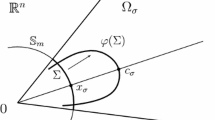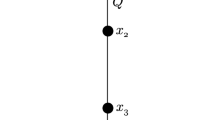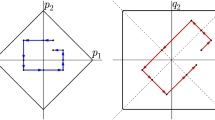Abstract
In this paper we use the equivariant Morse theory to give an estimate of the minimal number of central configurations in the N-body problem in ℝ3. In the case of equal masses we prove that the planar central configurations are saddle points for the potential energy. From this we deduce the presence of non-planar central configurations, for every N ≧ 4.
The principal difficulty in applying Morse theory is that the potential function is defined on a manifold on which the group O(3) does not act freely. To avoid this problem the equivariant cohomology functor is applied in order to obtain the Morse inequalities.
Similar content being viewed by others
References
Atiyah, M. F., & R. Bott, The Yang-Mills equations over Riemann surfaces, Phil. Trans. R. Soc. London, A 308 (1982), 523–615.
Bott, R., Lectures on Morse theory, old and new. Bull. Amer. Math. Soc., 7 (1982).
Conley, C. C., Isolated invariant sets and the Morse index, CBMS Regional Conf. Series in Math., 38 (1978), A.M.S., Providence, RI.
Conley, C., & E. Zehnder, Morse-type index theory for flows and periodic solutions for Hamiltonian equations, Comm. Pure Appl. Math. (to appear).
Fadell, E., & Lee Neuwirth, Configuration spaces, Math. Scand., 10 (1962), 111–118.
Husemoller, D., Fibre Bundles, Springer-Verlag (1966).
Husseini, S., The Topology of Classical Groups and Related Topics, Gordon and Breach, New York (1969).
Pacella, F., Morse theory for flows in presence of a symmetry group, MRC Tech. Summ. Rep. No. 2717.
Palmore, J. I., Measure of degenerate relative equilibria I, Annals of Math., 104 (1976), 421–429.
Palmore, J. I., New relative equilibria of the N-body problem, Letters Math., Phys., 1 (1976), 119–123.
Palmore, J. I., Classifying relative equilibria, Bull. Amer. Math. Soc., 81 (1975), 489–491.
Palmore, J. I., Central configurations, CW-complexes and the homology of projective plane, Classical Mechanics and Dynamical Systems (1980).
Palmore, J. I., Central configurations of the restricted problem in E 4, J. Diff. Eq., 40 (1981), 291–302.
Shub, M., Appendix to Smale's paper: Diagonals and relative equilibria, manifolds, Amsterdam (1970) (Proc. Nuffic Summer School), Lecture Notes.
C. L. Siegel, & J. K. Moser, Lectures on Celestial Mechanics, Springer-Verlag (1971).
E. Spanier, Algebraic Topology, McGraw-Hill Book Company, New York (1966).
A. Wintner, The Analytical Foundation of Celestial Mechanics, Princeton Math. Series, 5 (1941), Princeton University Press, Princeton, NJ.
Author information
Authors and Affiliations
Additional information
Communicated by R. McGehee
Rights and permissions
About this article
Cite this article
Pacella, F. Central configurations of the N-body problem via equivariant Morse theory. Arch. Rational Mech. Anal. 97, 59–74 (1987). https://doi.org/10.1007/BF00279846
Received:
Issue Date:
DOI: https://doi.org/10.1007/BF00279846




